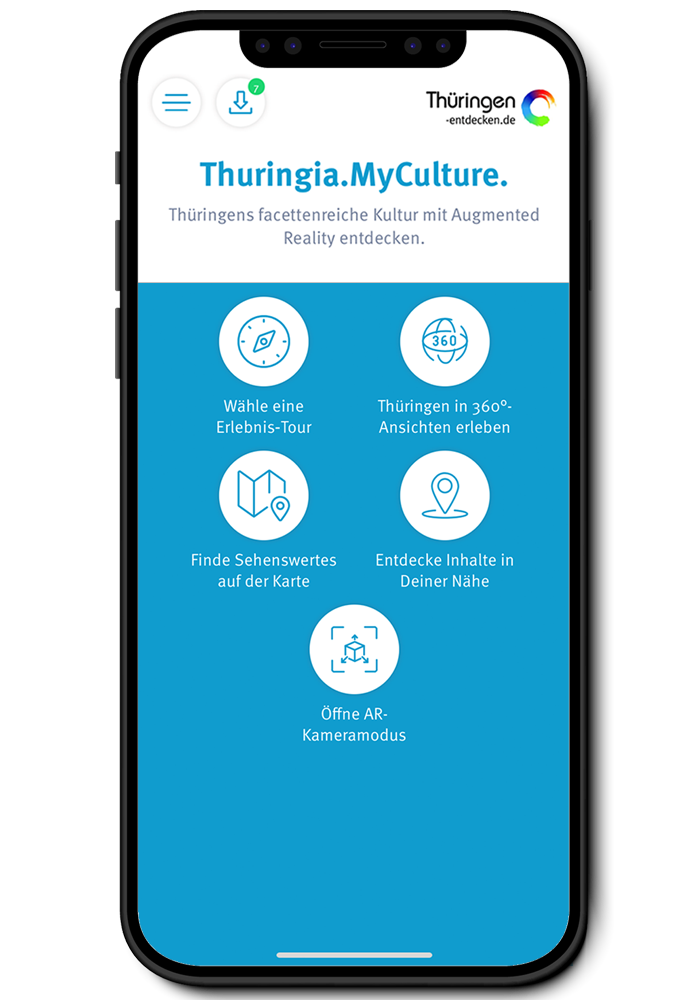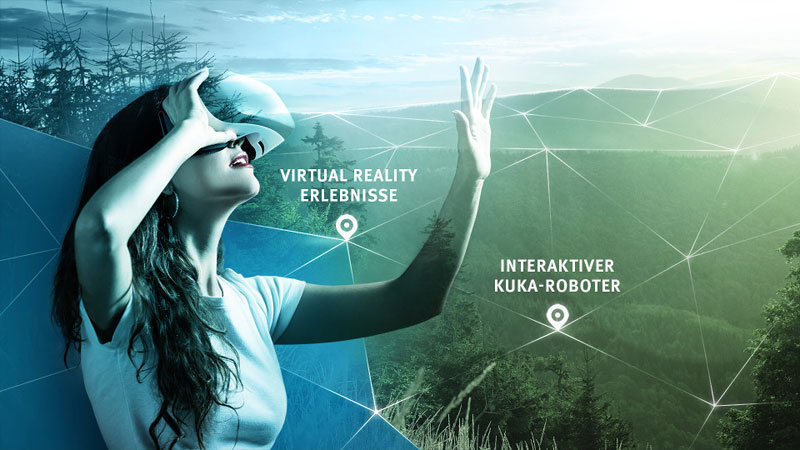Visit the state capital Erfurt and go on a virtual discovery tour through Thuringia.
A fantastically cunning monumental painting
Thuringia’s global art in Bad Frankenhausen
The address of the Panorama Museum in Bad Frankenhausen – “Am Schlachtberg 9” (On Battle Mountain 9) – hints at a historical background, but not at all at the fact that a unique art experience, which is now regarded as the “Sistine Chapel of the North”, has been created here in the middle of the countryside, outside the tranquil saltwater spa resort of Bad Frankenhausen. When you enter the round, windowless hall, the painting will take your breath away to begin with – that is how impressive the dimensions and the depiction of the thousands of figures and the real-looking landscapes are. Surrounding the art and culture tourist in a 360° view, there are, believe it or not, 123 metres of painting with a height of 14 metres. The canvas, which was actually produced in a single piece, weighs more than a tonne.
A monument of superlatives in Bad Frankenhausen
To honour one of the most tragic figures of medieval history, the theologian and radical Reformer Thomas Münster, and as a reminder of one of the last battles of the German Peasants’ War in the 16th century, a huge memorial was erected – at the scene of the events and with a monumental panoramic painting as the focal point. In 1976, the graphic artist, painter and art lecturer was commissioned to create this work by the East German Ministry of Culture. From a technical point of view, he was probably deemed to be the only person who would be capable of executing this project, which seemed virtually impossible. The building was opened in September 1989, just before Reunification.
Komplexbild as a basis for Tübke’s intellectual game of hide-and-seek
Bringing the specified subject matter onto the canvas purely as a visual historical narrative was much too easy, judging by Werner Tübke’s own high creative aspirations. Right at the outset, he stated that he would only agree if he were allowed to devise a complex image of the era that did not follow a linear historical development. He made a total of 13 demands, all of which were surprisingly approved.
Werner Tübke researched the subject for three years. As a basis for the scenes brimming with details, he primarily used well-known literary classics, each of which deals with the “fight for freedom” in their own way. In the process, Werner Tübke focused on historically proven events and bible passages, but also incorporated myths, stories and even his own life. He painted the underlying context into the figures and the typical scenes of the 16th century. “He invoked them,” says the art lover – and furnished them with innumerable details that reinforce the expressiveness of the painting, such as the intentionally oversized fox tail, which was seen as a symbol of subservience in the Middle Ages. Werner Tübke arranged every scene in the way that made scene in his head – bit by bit, the amazed visitor can work their way through it mentally.
Full of life like a theatre performance
The artwork could be regarded as a stage set for humanity’s revolutionary concept of freedom. And for the perpetual battle, which looks apocalyptic in Werner Tübke’s artistic universe, for the fulfilment of often very simple, but fundamental needs – to secure livelihoods, rights and co-determination and to protect life and limb. In this multifaceted pictorial world, the suggestion is made to the audience that they are part of the work. History plays out before you within touching distance. An execution that is particularly sophisticated in terms of both the painting and the structure – in some places using methods that are familiar from the art of the 16th century – makes the monumental painting extraordinarily vivid. And a multi-dimensional impression is created: a ledge can be perceived as such. Simply by mixing and applying paints that have an unfathomable luminosity, it was possible to compose a detailed specialist treatise. They even add realism to the seasons. Snow is made so palpable that you shiver when you look at it. The design of the hall’s floor, the lighting like an church and other tricks of the interior architecture enhance the enormously strong impact.
Contemporary witness and Tübke expert
Gerd Lindner studied the artist Werner Tübke at university. Since the end of the 1980s, he has worked at the museum as a research assistant. Not much later, after Reunification, he was appointed director. He met Werner Tübke a number of times. It was Gerd Lindner who first said that the artist was “fantastically cunning” to foist this work onto the regime of the time – anyone who is familiar with East German art knows that his depiction of the “Early Bourgeois Revolution in Germany” most certainly did not correspond to the actual ideas of the Ministry of Culture at the time. However, the painter assumed that is work would not be understood anyway.
As a template for his picture in the Panorama Museum in Bad Frankenhausen, he created a painting on a scale of 1:10. In the “Tübke Cabinet” area, the entire creative process behind the panoramic painting is presented vividly. The 20-minute documentary film “Schlacht am Bild” (Battle of the Painting) clearly shows the immense physical and mental challenges that faced Werner Tübke and everyone involved at the time.
Recommended reading
Think what you want – the “freiheyt” (freedom) of our times
Museum director Gerd Lindner encourages visitors to discover and interpret the painting for themselves. “Because there is a lot of it and it is very complex!” he says succinctly. The artist himself, Werner Tübke, left the greatest possible scope – he never said anything about what he had painted. This also had another advantage: “At the time of Reunification, the painting turned out to be aesthetically weatherproof,” states Gerd Lindner “because Werner Tübke avoided specifically pointing towards a particular ideological orientation by only citing the original sources in pictorial form and not following the interpretations of the historians of what was then East Germany.”
Clearing your head again
The museum café with a glazed front façade and a terrace in the summer offers regional specialities and has a wonderful view of the landscape. A number of hiking routes, including the Kyffhäuser Trail, run around the Panorama Museum. A walk goes well with the cultural experience. In the fresh air, you are better able to sort out what you have seen in your mind’s eye, silently remembering those who lost their lives fighting for their freedom on this spot.
It goes almost without saying that the Panorama Museum has been chosen as one of the locations for the State Exhibition in 2025. After all, the location in its entirety expresses the different ways and means that people adopt to assert their very personal understanding of freedom. The dynamism of Werner Tübke’s artwork appears even more vivid because of the originals and copies that inspired him and have been brought together as international loans for the State Exhibition.
Header: ©ZK Medien, Panoramamuseum Bad Frankenhausen
Graphic in the website block: Sebastian Köpcke, Mühlhäuser Museen
Accessibility
Did you like this story?
You might also be interested in ...
















